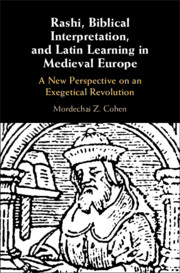 Rashi, Biblical Interpretation, and Latin Learning in Medieval Europe
Rashi, Biblical Interpretation, and Latin Learning in Medieval Europe Book contents
- Rashi, Biblical Interpretation, and Latin Learning in Medieval Europe
- Rashi, Biblical Interpretation, and Latin Learning in Medieval Europe
- Copyright page
- Dedication
- Contents
- Acknowledgments
- Abbreviations
- Introduction
- 1 A New Program of Peshat (“Plain Sense” Exegesis)
- 2 “Settling” the Words of Scripture Using Midrash
- 3 St. Bruno on Psalms: Precedent for Rashi?
- 4 Comparison to the Andalusian Exegetical School
- 5 Comparison to the Byzantine Exegetical School
- 6 Rashi’s Literary Sensibilities and Latin Grammatica
- 7 Rashi’s Notion of “the Poet” (ha-Meshorer) in the Latin Context
- 8 Joseph Qara and Rashbam: Peshat Legacy in Northern France
- 9 Literary Sensibilities of Peshat within a Latin Context
- Bibliography
- General Index
- Index of Scriptural References
- Index of Rabbinic Sources
7 - Rashi’s Notion of “the Poet” (ha-Meshorer) in the Latin Context
Published online by Cambridge University Press: 15 April 2021
- Rashi, Biblical Interpretation, and Latin Learning in Medieval Europe
- Rashi, Biblical Interpretation, and Latin Learning in Medieval Europe
- Copyright page
- Dedication
- Contents
- Acknowledgments
- Abbreviations
- Introduction
- 1 A New Program of Peshat (“Plain Sense” Exegesis)
- 2 “Settling” the Words of Scripture Using Midrash
- 3 St. Bruno on Psalms: Precedent for Rashi?
- 4 Comparison to the Andalusian Exegetical School
- 5 Comparison to the Byzantine Exegetical School
- 6 Rashi’s Literary Sensibilities and Latin Grammatica
- 7 Rashi’s Notion of “the Poet” (ha-Meshorer) in the Latin Context
- 8 Joseph Qara and Rashbam: Peshat Legacy in Northern France
- 9 Literary Sensibilities of Peshat within a Latin Context
- Bibliography
- General Index
- Index of Scriptural References
- Index of Rabbinic Sources
Summary
Rashi’s conceptual and terminological innovations are sometimes difficult to discern because he draws his vocabulary almost exclusively from rabbinic sources. However, as we have seen in the earlier chapters of this study, there are cases in which he uses traditional Hebrew and Aramaic terminology in innovative ways to advance his new interpretive agenda. This is especially true of his usage of the Hebrew term ha-meshorer in the sense of the poet, which is the subject of the current chapter. As we shall see, Rashi innovatively uses this term, as well as the related term kotev ha-sefer, to connote the implied author-narrator of the biblical text. This literary construct is invoked by Rashi to explain scriptural literary structure in ways that are illuminated by the poetic conceptions articulated among his Latin neighbors.
- Type
- Chapter
- Information
- Rashi, Biblical Interpretation, and Latin Learning in Medieval EuropeA New Perspective on an Exegetical Revolution, pp. 187 - 206Publisher: Cambridge University PressPrint publication year: 2021
